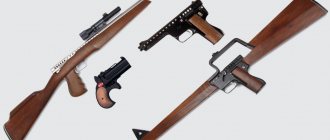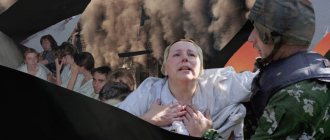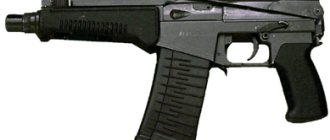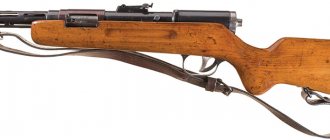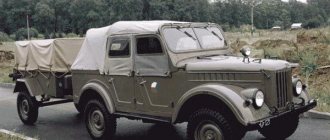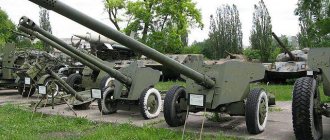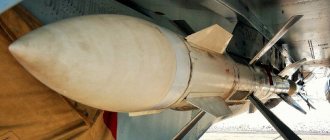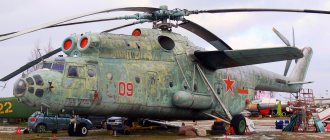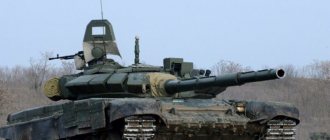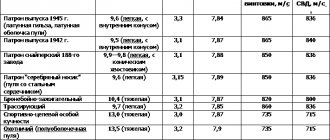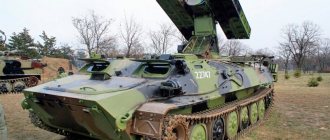This term has other meanings, see Bullet (meanings).
| Wiktionary has an entry for " bullet " |
Minié bullet Lead sling bullets with the inscription “catch it”, Greece, Athens, 4th century BC.
e. Bullet
(presumably from the French boule - ball, or Polish kula - core [1]) - a projectile (damaging element) of small arms. Bullets are also the name given to small projectiles used in slings and ancient mechanical artillery. The two main features of bullets - long firing range and high lethality - are due to one physical phenomenon - inertia.
In the 19th century, before the advent of Minié bullets for muzzle-loading rifles, the bullets were spherical. Since bullets for muzzle-loading rifles must be somewhat smaller than the diameter of the barrel (otherwise loading the gun would be very difficult), they were placed in the barrel along with a wad, which served as a seal. With the advent of breech-loading weapons, bullets began to be made with a slightly larger diameter than the barrel so that the bullet could fit into the connection with the rifle.
A variant of the bullet is the so-called "flechette" - a arrow-shaped projectile that was used by the US Army as ammunition for military shotguns during the conflicts in Korea and Vietnam. Such military ammunition is currently prohibited by international agreements.
Dum-dum bullets are also banned, despite their popularity among hunters.
Content
- 1 Bullets for live ammunition
- 2 Bullets for hunting cartridges
- 3 Bullets for sniper rifles
- 4 Types of bullets 4.1 Ball-shaped
- 4.2 Armor-piercing
- 4.3 Shell
- 4.4 Shell expansive
- 4.5 Combined
- 4.6 Easily destroyed
- 4.7 Flat head shell
- 4.8 Semi-shell with expansive recess
- 4.9 High speed with high stopping power and low penetration
- 4.10 Managed
- 4.11 Bullets for air guns
- 5.1 Hunting bullets
Bullets for live ammunition
Bullets for live ammunition are divided into ordinary and special. The main type of bullet is an ordinary bullet. Special ones include armor-piercing, incendiary, and tracer. Ordinary and armor-piercing bullets affect the target only mechanically, hitting them with the force of impact. There are also expansive (expanding) and explosive (exploding) bullets, but their use in combat is to destroy manpower
prohibited by the 1899 Hague Convention.
However, such bullets were repeatedly used in combat even after the adoption of the Hague Convention, and are still used on a limited scale today[2]. For example, bullets of the MDZ type (instantaneous incendiary) and their foreign analogues are de facto
explosive; they are used for firing from machine guns at low-flying airplanes and helicopters, and occasionally at other targets.
Ordinary shot and buckshot also formally belong to the category of expansive bullets; accordingly, de jure
combat shotguns are also prohibited for use in manpower.
The structure of a modern cartridge: 1.
Bullet (projectile);
2.
Sleeve that combines all parts;
3.
Powder charge;
4.
The cap of the cartridge case, by which it is removed from the barrel after the shot;
5.
Primer that initiates the explosive.
The structure of an ordinary bullet is simple: usually such bullets consist of a lead core enclosed in a shell of a harder material (for example, cupronickel, brass or steel coated with a layer of tombac). A steel core is sometimes located in the head part to increase penetration.
In armor-piercing bullets, the core is made of hard alloys. The lead core is still retained to increase mass and packing density.
Incendiary and tracer bullets contain additional special chemical compounds. Ignition of the tracer composition during a shot occurs from powder gases; for this, an auxiliary ignition composition is used.
The longer the bullet, the greater its lateral load (the ratio of mass to unit cross-sectional area), the higher the conservation of energy along the trajectory, the flatness of the trajectory, and the kinetic energy.
Over time, a slightly lighter, pointed bullet type was established. The flight trajectory of such bullets, due to the reduced mass, and therefore the lateral load, and due to the increase in initial speed due to this, turned out to be more sloping at the beginning and steeper at the end.
Pointed bullets, which have a higher flight speed, had the ability to spread the impact force in a circle to the sides, thereby increasing their damaging effect (destructive effect). Sometimes, to increase the destructive effect of a bullet, its center of mass is shifted to the tail.
For this purpose, for example, in the English bullet Mk-VII (1914), the core is not made entirely of lead, but with an aluminum or fiber head, and in the Japanese bullet, due to the unequal thickness of the shell walls, the bulk of the lead core was concentrated in tail section. Finally, the heavy core may not occupy the head of the bullet, leaving it hollow and, therefore, light (bullet for the 5.45x39 mm cartridge). When meeting an obstacle, especially in that part of the trajectory where it has already noticeably deviated from the throwing line, such bullets exhibit the ability, due to the phenomenon of precession (“drives with the nose”), to sharply change their position and penetrate the obstacle not with the head part, but with the side . Other methods are also used to increase stopping power.
Application specifics
Explosive bullets MD of aviation cartridges 12.7x108 mm during the Great Patriotic War.
First of all, such bullets were used by snipers to destroy charging boxes. Later they began to be used as a measure to increase the reach of fire due to the visible gap and increased destructive power of the bullet at exhaustion. It should be noted that at close and medium distances, an explosive bullet is only slightly more effective than an expansive bullet, but is much more expensive to manufacture.[5] There is evidence that during the Great Patriotic War, explosive bullets were widely used by German Jaeger units, since in mountainous conditions it is very difficult to immediately aim accurately. Today, the use of explosive bullets against enemy personnel is not only prohibited, but is also considered unjustified, since all problems are effectively solved by cheaper methods. However, large-caliber explosive bullets for hitting the enemy behind lightly armored shelters are still being created and produced.
Despite the existing international ban, explosive bullets found widespread use in aviation during the First World War, as they were very effective in the fight against balloons and weakly protected enemy aircraft. It is also important that the flashes of explosions of such bullets, clearly visible even in the daytime, allow you to adjust the shooting in anticipation of the actual result (tracer bullets appeared later and do not allow you to see the hit itself). During World War II, small calibers were gradually replaced by more effective armor-piercing incendiary non-explosive ammunition. Large-caliber explosive-type incendiary bullets still have some use in aviation.
In artillery, sighting bullets were used to adjust fire, but at close ranges they are now completely replaced by tracer bullets. In addition, rifle-caliber explosive (HE) bullets are widely used in training artillery crews, as they are much cheaper than full-size projectiles.
Bullets for hunting cartridges
Bullets for hunting cartridges are usually two-element - a jacket and a lead core. The classic 7.62 mm bullet with a pointed jacket is called FMJ (full metal jacket). Expansive ones are also used for hunting.
bullets. They allow you to increase the effectiveness of hitting a target. The semi-jacketed SP (soft point) bullet has a jacket that is open at the front and closed at the rear. The lead core peeks out from the shell. For a hollow point HP (hollow point) bullet, the jacket is also open at the front, but the lead does not peek out, but remains at some depth. Expansive bullets open up when they hit a target, very quickly releasing energy to the victim, while causing severe damage, tearing muscles and destroying bones.
Small-caliber bullets of the .22LR type (5.6 mm caliber) are unjacketed and made entirely of lead. Such bullets are used to hunt small animals: sable, squirrel, etc. They are also used for shooting in biathlon and bullet shooting competitions. Expansive bullets are also available in this caliber.
The above-mentioned bullets are used for rifled hunting rifles and carbines. For smooth-bore guns, many variants of caliber and sub-caliber bullets are used, mostly unsheathed from lead and its alloys (although there are exceptions - “lead-free” bullets made of copper and brass, sub-caliber steel bullets). Some of these bullets are aerodynamically stabilized in flight and have a design with a heavy head and a light, elongated tail (sometimes plastic and with fins) - arrow bullets. Others have ribs or cutouts located at an angle to the longitudinal axis on the outer surface and/or in a through internal channel, designed to spin the bullet around the longitudinal axis by the incoming air flow (turbine bullets). There are also combinations of these two types (arrow-turbine), unstabilized bullets (the simplest is a ball), bullets with leading bands, intended for shooting from guns with a “paradox” drill - a rifled section at the muzzle of a smooth barrel (according to the Law on Weapons of the Russian Federation with the length of the rifled part up to 14 cm is considered a smooth-bore weapon). Many caliber bullets have a body of smaller diameter than the bore, and rather thin and easily crimped bands to the diameter of the bore, ensuring the bullet is fixed in the barrel and securely sealed without excessive resistance to its movement. Sub-caliber bullets are used in a sealing plastic container. The best examples, with properly selected weapons, provide an effective combat range of up to 150 and even 200 meters with accuracy comparable to that of hunting rifled weapons.
Classification of cartridges
As mentioned earlier, the bullet was not always part of the cartridge; in addition, there are a number of cartridges that do not contain a bullet:
- Signal.
- Single.
The purpose of signal cartridges can be understood from the name. Instead of a bullet, they use a special mixture that produces a bright fire when ignited. A shot is simulated using blank cartridges.
In addition to the above, cartridges can be classified into:
- Combat ones are exactly those that are imagined when the word cartridge is mentioned. That is, a device for hitting a target.
- Training cartridges in their shape, weight and appearance completely imitate combat cartridges and are intended for teaching the basics of shooting.
- Hunting cartridges differ in appearance from combat cartridges and instead of bullets, as a rule, they have a handful of metal balls - shot.
- Construction cartridges are designed to create powder gases, which, with their pressure, drive a special nail - a dowel - into the wall.
In addition, cartridges can be divided into:
- Unitary.
- Composite.
Unitary is the familiar one-piece cartridge that contains all of the above components.
The compound cartridge is primarily used in heavy artillery systems in which it is difficult for a person to load the gun with a unitary cartridge. To do this, the ammunition is supplied with a capsule separately and they are connected in the gun barrel.
Types of bullets
| This section needs to be completely rewritten. There may be explanations on the talk page. |
Ball-shaped
Ball-shaped bullets Ogival-shaped bullets - lead unsheathed and with a copper alloy jacket.
A spherical bullet (English round; English ball, abbr. B) is a traditional bullet in the form of a ball made of pure soft lead. Currently, this type of bullet is used for shooting from hunting smooth-bore weapons and modern replicas of muzzle-loading weapons.
Armor-piercing
Main article: Armor-piercing bullet
Armor-piercing bullet (English armor piercing, abbr. AP) - a bullet with a core made of antimony lead or with a steel core in a lead jacket. Bullets with a steel core have greater penetration power. For example, domestic families of pistol cartridges (7.62 mm TT cartridge, 5.45 mm PSM cartridge, 9 mm PM cartridge) include cartridges with bullets with lead and steel cores.
Shell
Main article: Full metal jacket bullet
Jacketed bullet (eng. full metal jacketed, abbr. FMJ) - a bullet with a relatively hard shell around the core, which prevents the bullet from breaking off the rifling and helps the bullet maintain its shape when passing through an obstacle (improved penetrating effect of the bullet). Such a bullet can have either a round or pointed nose. Most modern bullets are jacketed.
Shell expansive
Main article: Expansive bullet
Expansive (expanding, English expanding full metal jacketed, abbreviated EFMJ) bullets, for example, the Extended Range bullet, provide for a significant increase in diameter when entering tissue in order to increase the stopping effect and / or reduce the depth of penetration. Such bullets are widely used in police and hunting weapons, but are prohibited for use in military weapons. Expansive bullets are conventionally divided into deformable (non-destructible), semi-destructible and collapsible.
Combined
Main article: SOST (bullet)
A combined bullet (English: SOST, from Special Operations: Science and Technology) is a bullet that simultaneously combines the functions of expansive and armor-piercing: it has a hollow tip and a solid core, which simultaneously provides increased lethality and penetrating ability. Modern military bullets in service with the United States are of the combined type.
Easily destructible
Glaser Safety Slug Bullet
Easily breakable (with so-called controlled ballistics [ unknown term
];
English Glaser Safety Slug - the name of the company that developed it) bullet - a bullet filled with pellets (usually over 30 pellets; over 200 pellets for a .38 Special bullet) and Teflon liquid, closed with a plastic cap, for shooting at unprotected people in conditions where it is necessary to fully exclude ricochets and penetration through (for example, in an airplane cabin). When it hits a target, the bullet is destroyed, forming a conical stream of fine [ how much?]
] shot, causing severe damage. When hitting solid objects, the bullet is easily destroyed without ricochets.
Black Top Glaser Safety Slug is a modification of the bullet that is capable of penetrating light barriers while maintaining a high wound impact.
Flat head shell
A jacketed flat point bullet (abbr. JFP) is a bullet that, due to its flat head, provides less ricochet and a greater stopping effect.
Semi-shell with expansive recess
A semi-jacketed bullet with an expansive notch (English hydra-shok) is a bullet with a core made of two parts (rubber head and lead) and a tombak shell with deep longitudinal cuts. The bullet is designed so that the expansion is fully manifested in soft obstacles. When penetrating, for example, plywood, the bullet practically does not expand [ source not specified 3290 days
].
High speed with high stopping power and low penetration
THV bullet
A high-speed bullet with a high stopping effect and low penetrating power (French très haute vitesse, abbreviated THV) - a light (hollow head) high-speed bullet, due to its special shape (English reverse ogive - reverse envelope) when it hits the body target, spreading the shock wave not forward, but to the sides, quickly decelerating with the transfer of significant energy to the target’s body (increasing the stopping effect). The shock wave greatly disorients the target. The strongly pointed head part also increases armor penetration: the permeability of armored fabrics improves due to the spreading of fibers without breaking, armor plates - due to splitting by a point application of impact.
THV bullets were developed in France. Similar bullets are used to equip cartridges for pistols and revolvers of caliber from 7.65 to 11.43 mm. They are used exclusively by special units, in particular by NATO forces as special ammunition; sale to civilians is not provided.
Managed
Scientific and technological progress in the field of military technologies, in particular the miniaturization of electronics, the transition to mass production of submicron microchips, as well as the creation of miniature maneuvering rocket engines, led to the fact that in the mid-1980s the American military industry came close to creating guided bullets, otherwise called “smart bullets ”
), - management representatives reported on the successful completion of the next milestone on the path to this in August 1986, following the results of successful tests of 40-mm tank guided sabot projectiles, subject to further miniaturization of which by two to three times it was quite possible to achieve controllability of large-caliber bullets, however, the very first feasibility studies of this issue by budget monitoring bodies showed that even if the tactical and technical requirements for guaranteed destruction of targets at a given distance are improved to an acceptable level and mass production of this kind of weapon is launched, it will be incredibly expensive and complex not only in production, but also in operation and maintenance[3][4].
Airgun bullets
Bullets for air guns The top row is .22 caliber, the bottom row is .177.
Air guns are produced in small and medium calibers. Small calibers include 4.5 calibers; 5; 5.5 and 6.35 mm; to average - 7.62; 8 and 9 mm. Pneumatic weapons of other calibers are very rare, for example, 11.43; 12.7; 14.7 and 22 mm. In English-speaking countries, it is customary to indicate the caliber of a weapon to hundredths of a millimeter (Metric system) or thousandths (Imperial system) of an inch, without a leading zero. Mutual conversion of calibers from one system of measures to another usually gives an approximate value, since it affects not only the rounding of the conversion, but also the historical designations of calibers, measurement tolerances and manufacturing tolerances. Thus, calibers 4.5; 5; 5.5 and 6.35 mm correspond to the designations .177, .20, .22 and .25. The caliber of the barrel and the caliber of the bullet usually differ by a few hundredths of a millimeter. The bullet length of the most popular 4.5 mm caliber usually ranges from 5 to 9.5 mm, which must be taken into account when choosing bullets for weapons with a magazine feed or a rising bullet receiver.
For shooting from air guns, darts, spherical steel bullets, lead bullets, aluminum bullets, plastic bullets with a sub-caliber core and some others are used. Darts and ball-shaped steel bullets are intended for smooth-bore weapons, and lead, aluminum and plastic bullets are for rifled weapons.
New in blogs
In the 17th century, Cardinal Richelieu ordered the inscription Ultima ratio regum (“The Last Argument of Kings”) to be minted on all cannons cast in France. A century later, the Prussian king Frederick II decided to follow his example: the inscription on the Prussian cannons read: Ultima ratio regis (“The King’s Last Argument”).
But the simple infantryman always put an end to the conflicts of the warring parties.
It was he who burst into the last enemy stronghold and pointed his gun at the enemy king. Looking into the trunk, where a small lump of lead was hidden, the loser put his signature on the act of surrender. This lump is called a bullet.
The bullet of modern small arms comes from the balls that ancient warriors threw from a simple but very effective device - a sling. As you know, the frail and short David defeated the huge and powerful Goliath with the help of a stone thrown from a sling.
When gunpowder was invented and the first cannons appeared, their cores were made of stone, and later of cast iron. The first guns were originally loaded with round lead bullets. They were made simply - they made a groove in the ground into which molten lead was poured. The lead rod was chopped into pieces and shaped into a ball by rolling them between two cast iron plates.
Gun calibers in those days were determined not by millimeters or fractions of an inch, as they are today, but by the number of bullets that could be cast from one pound of lead (454 g). This tradition continues in hunting rifles - "16 gauge" means that one pound of lead will produce 16 bullets.
Until the second third of the 19th century, the world practically did not know any other bullet, although already in the 15th century it satisfied shooters little. Many attempts have been made to come up with something more perfect. The bullet was the main obstacle to increasing the rate of fire and range of guns, and their accuracy: a lead ball at a distance of 300 m gave a deviation of up to 2 m.
To improve accuracy, already in 1615, guns with rifled barrels appeared, which made the bullet rotate, which provided a significant increase in both accuracy and firing range. However, for such a gun it was necessary to make bullets of a smaller diameter than the diameter of the bore, and having lowered it into the barrel, expand it with hammer blows on the ramrod. At the same time, the bullet was deformed, which affected the shooting accuracy and flight range.
Of course, the design idea did not stand still, but these inventions did not provide significant advantages compared to a simple spherical bullet. Winning in one led to even greater losses in the other.
Not a ball
In 1848, the French captain Minier found a truly brilliant solution. What if the powder gases themselves expand the bullet - and not a spherical one, but an oblong one? He inserted a copper cap into the bottom of the bullet; when fired, the impact of the powder gases drove it into the soft lead like a wedge. The bullet expanded and pressed tightly against the rifling. The Minié rifle was as easy to load as a smoothbore gun, but was three times more powerful.
But the Minie bullet was destined for a short life. Quite soon, gunsmiths began to use a unitary cartridge invented at the beginning of the 19th century - a metal cartridge case for charging gunpowder, into which a bullet was inserted on top. It became possible to load a rifle not from the muzzle, but from the breech. A bolt began to be used, which unlocked and locked the bore. The cartridge case, expanding when fired, was pressed tightly against the walls of the channel and prevented the gases from breaking back.
Now it turned out to be sufficient to make the breech part of the barrel, where the cartridge is placed, a little larger in diameter, and move the rifling a little further. When fired, the bullet, starting to move in the barrel, itself crashes into the rifling.
This is how the familiar cartridge with an elongated bullet appeared. By the way, if you measure the diameter of a 7.62 mm bullet with a precision instrument, you will be surprised to find that it is not 7.62 mm, but 7.92 mm. In fact, the caliber is determined not by the diameter of the bullet, but by the diameter of the bore based on the rifling protrusions: this is 7.62 mm. The 0.3 mm difference ensures that the bullet rotates along the rifling.
Therefore, statements that the caliber of the Soviet three-ruler was 7.62 mm, and the German one - 7.92 mm, may look strange, but are explained by differences in the definition of caliber. In some countries it is defined as the distance between the fields of the rifling (the smallest diameter of the bore), in others as the distance between the bottoms of the rifling (the largest diameter).
If rotation in flight is desirable for a round bullet, then it is mandatory for an oblong bullet. Such a bullet, being fired from a smoothbore gun, immediately begins to tumble and yaw. Hitting the target with it is even more difficult than with a round one. Therefore, elongated bullets did not find use in army smoothbore guns, although such attempts were made several times.
The reason for the yaw and tumble of the bullet is that the center of application of aerodynamic forces (center of pressure) and the center of gravity do not coincide (usually for technological reasons). Couples of forces arise that knock the bullet over and make it yaw. The rotation of the bullet makes it a kind of gyroscope, and, like any gyroscope, it maintains its position in space unchanged - with its nose forward.
The smaller the eccentricity (the distance between the centers of gravity and pressure) of the bullet, the more accurately it hits the target (experts say: “higher accuracy”). And this is the main concern of those who develop cartridges. The most successful cartridges in design remain in service for many decades, moving from one type of weapon to another.
For example, the bullet of the famous Mauser pistol with a caliber of 7.63 mm, which appeared at the end of the 19th century, was later used in the Soviet TT pistol, PPD, PPSh, PPS assault rifles and a number of other pistols. And the TT pistol owes its popularity in the world largely to the successful choice of cartridge.
Bullet expansion
At the end of the 19th century, a revolution took shape in military small arms: the transition from black smoky powder to smokeless. At the same time, the caliber of the weapon decreased (6.5–8 mm instead of 10–12 mm). To improve the ballistic characteristics of bullets fired from such weapons, they began to be coated with a metal shell. However, it turned out that the new small-caliber jacketed bullets had too weak a stopping effect, penetrating the enemy right through and leaving neat entry and exit holes.
The solution to this problem in the mid-1890s is attributed to Captain Clay of the British Dum Dum Arsenal near Calcutta, who was developing .303 caliber bullets for the Lee-Metford rifle. Contrary to popular belief, Clay did not make cross-shaped rifling (they appeared later as a cheap way to make hollow-point bullets in the field), but suggested simply sawing off the nose of the bullet, as a result of which it became semi-jacketed. Once in the body, such a bullet was deformed, “opening up” and giving away all its energy. The penetrating effect of the bullet decreased, and the stopping effect increased. The name of the arsenal stuck and became a household name for expansive (“expanding”) bullets.
When hitting soft tissue, the hollow-point bullet caused severe injuries. For this reason, just a few years later, at the first Hague Peace Conference in 1899, bullets that expand and deform in the human body were prohibited for military use. The IV Hague Convention in 1907 confirmed the ban, but during subsequent wars many countries repeatedly “forgot” about it.
Expansive bullets are still widely used today - not in military conflicts (this is still prohibited), but as hunting ammunition. In addition, hollow-point bullets are widely used in police weapons: high stopping power is combined with a low probability of hitting a target (this reduces the risk of hitting bystanders).
The tombak or cupronickel shell plays another role - it ensures a constant geometric shape of the bullet when carrying cartridges in pouches, as well as at the time of loading, which has become especially important for multi-shot rifles. In addition, contamination of the barrel bore rifling with lead and the bullet being pulled off the rifling were prevented. And the penetration ability of a bullet in a hard shell turned out to be higher than that of a simple lead bullet.
The same Hague Convention, based on the principles of humanism, prohibited the use of bullets that do not have a hard shell at the front. This ban (a rare occurrence) has been strictly observed by all countries for a hundred years. True, the reason is not that everyone is imbued with the principles of humanism, but that the jacketed bullet better fulfills its main purpose - to kill.
Armor and fire
With the advent of armored vehicles on the battlefields of World War I, bullets capable of penetrating armor were needed. The strength of the tombak or cupronickel shell was no longer enough. Then a steel core was placed inside the bullet. The lead in the bullet gradually began to transform from the main material into a weighting agent. The heavier the bullet, the more kinetic energy it has.
When it meets the armor, the shell is destroyed, and the solid steel core pierces it (the lead in the head of the bullet to some extent prevents the core from sliding to the side when the bullet does not meet the armor at a right angle). The cores differ in size, degree of sharpness and shape - from simple cylinders to complex spindle-shaped ones. In addition to steel, harder materials were also used (for example, the Germans used a tungsten carbide core).
An armor-piercing bullet pierced armor, but that was where its effect was limited. They also needed bullets that could set fire to highly flammable materials. This is how incendiary and armor-piercing incendiary bullets appeared. The first contained an incendiary composition, usually white phosphorus, in the head part, and worked well against targets unprotected by armor - wooden houses, thatched roofs, haystacks. When a bullet hit, its shell was destroyed, and the incendiary composition ignited upon contact with air and set the target on fire.
When it hit a person, the bullet opened like a flower, similar to expansive ones, and even very poisonous phosphorus got into the wound. But the First World War was already underway, and the apt remark of the Italian General Douhet: “... all restrictions, all international agreements that can be established in peacetime will be swept away like dry leaves by the wind of war” - turned out to be prophetic. Armor-piercing incendiary bullets were designed similarly to armor-piercing ones, but either in the head or in the bottom they also had an incendiary composition. Such bullets were intended primarily for firing at fuel tanks of cars.
Fire Arrows
With the advent of machine guns, the firing of which had to be constantly adjusted, bullets were needed whose trajectory would be visible—tracers. In addition to lead, the shell contains a container with a pyrotechnic composition, open at the back. When fired, the composition is ignited by powder gases and burns with a bright fire of red, green, yellow or blue. It burns for only 2–3 seconds, but at a speed of 900 m/s it is about 2 km. The luminous trace of such a bullet is clearly visible even during the day, but not to the shooter himself (he looks directly after it), but to the commander or assistant located on the side.
The second purpose of tracer bullets is target designation. The squad leader always has one magazine, filled only with tracer cartridges. Several long bursts of tracer bullets at a single target - and all squad shooters transfer fire to this target.
There are also quite exotic bullets, such as sighting bullets. When such a bullet hits a surface, it explodes, throwing out a white cloud of smoke that is clearly visible from a distance. It indicates exactly where the bullet hit (a tracer bullet shows the direction of flight well, but not the point of impact). The sighting bullet has inside a simple fuse in the form of an inertial striker, a primer with a certain amount of explosive and a small amount of smoke-generating pyrotechnic composition.
These bullets have no combat value, since the explosive charge is very small and small fragments of the shell cannot cause serious injuries. As a rule, such bullets are used when training artillery officers at miniature training grounds, where training mock-ups of tanks, vehicles, and buildings are installed at short distances. The explosion of such a bullet simulates the explosion of an artillery shell, and officers learn to determine the range, deviations of explosions from the target and make corrections.
Pistol bullets
As a rule, pistol bullets are either simply jacketed/semi-jacketed, or have a steel core inside to increase penetration. Sometimes you can find pistol tracer bullets and even quite exotic ones - armor-piercing incendiary bullets. But they are intended for firing from submachine guns at ranges exceeding the normal firing distance from pistols or revolvers.
A significant difference between pistol bullets and rifle bullets is their shape. A rifle or machine gun bullet requires a long flight range, which means good aerodynamics. The sharpness of the bullet also provides it with significant penetrating ability at long distances. A pistol bullet requires high stopping power and quickly incapacitating the enemy (at least for a few seconds).
And if in long-range small arms over the past 150 years we have observed a steady trend towards decreasing calibers (Peabody-Martini rifle model 1869 - 11.43 mm, AK-74 assault rifle model 1974 - only 5.45 mm), then the calibers of pistols and revolvers practically do not change. Many researchers consider 9 mm to be the minimum appropriate caliber. The common caliber 7.62 mm, in their opinion, is insufficient due to the weak stopping effect of the bullet.
Marking
In Russia, it is customary to paint the heads of rifle bullets in the following colors: a regular bullet - without painting, an incendiary bullet - red, an armor-piercing incendiary bullet - black with a red belt, a tracer - green. With reduced speed (subsonic, for silent shooting) - black with a green belt. Exemplary (reference) cartridge (with increased accuracy of ballistic characteristics) – white. With a reinforced charge (for testing under production conditions) - the entire bullet is painted black. This coloring of bullet tips in Russia is also used for all other cartridges, except large-caliber ones.
In the Wehrmacht during World War II, color markings were different. Cartridges with a heavy bullet had the joint between the case head and the primer sealed with green varnish, armor-piercing ones – red. The armor-piercing cartridge with a tungsten carbide core had a primer painted entirely red, and with an iron core - white. The tip of the cartridge with a sighting bullet was painted gray. Cartridges with tracer bullets had a green stripe along the head of the case. There was much greater discord in the armies of Great Britain and the United States.
Military marketing
There are many myths about “bullets with a shifted center of gravity”, which were allegedly used to equip cartridges for the Soviet AK-74 assault rifle. What kind of secret weapon is hidden under this term? The 5.45x39 bullet with index 7N6, like almost any oblong bullet, has eccentricity (the center of gravity and the center of pressure do not coincide). 7N6 has a steel core and an internal cavity in the head, which causes the center of gravity to shift towards the tail.
The 5.45 mm caliber and low-pulse cartridge led to a significant reduction in stopping power. And in order to increase the destructive power, the bullet was simply “under-twisted”. The result was an increased likelihood of a rebound, easy derailment, and the accuracy left much to be desired.
However, military marketing was able to “transform” disadvantages into supposed advantages: as many sources write, “this ensures that the bullet loses stability when it encounters an obstacle, which gives it an additional lethal effect.” Of course, it is possible to create an even more unstable bullet with a greater lethal effect. It’s just impossible to hit an enemy with such a bullet.
Story
| This article or section needs revision. Please improve the article in accordance with the rules for writing articles. |
The bullet appeared at the same time as the handgun. For the first samples of such weapons (hand bombards), pieces of lead (sometimes iron or other metal) of the appropriate size were used as bullets. The shape of the bullets was usually close to spherical, but this was not considered necessary. The diameter of the first bullets could be significantly smaller than the caliber of the weapon. This was partly due to the low level of technical development, partly due to the lack of deep knowledge of ballistics among the masters of that time.
With the spread of firearms in European armies, bullets began to be made almost exclusively from lead, and efforts were made to give them a regular round shape. In the 16th century, in European muskets the bullet weighed up to 52 g, its caliber reached 21.6 mm. With a decrease in the caliber of the musket, the weight of the bullet also decreased, because it always remained a ball - by the end of the 17th century, a type of infantry, smooth-bore gun was established in Europe, with a caliber of 16-18 mm (in Russia - 17.78 mm), the bullet for it weighed about 25.6 g. The diameter of the bullet still did not match the caliber of the weapon. In Russia, it was officially believed that a gap of 5 to 7 points (1.27-1.78 mm) was required for loading, but in practice this requirement could only be met for new weapons: with prolonged use, the barrel of a gun loaded from the muzzle was inevitably worn out by a cleaning rod, and its caliber gradually increased (this problem was especially acute in Russia, where soldiers cleaned barrels with crushed bricks). When rubbing the barrel, the gap between the bullet and the walls of the barrel increased, which negatively affected accuracy and firing range.
For rifled guns that appeared in the 16th century (fittings and carbines), a spherical bullet of almost the same diameter as the barrel was adopted. When loading, such a bullet was wrapped in a “plaster” (a piece of dense fabric) and driven into the barrel with a ramrod and struck with a hammer. In rifled weapons of that time, it was necessary to use a reduced charge of gunpowder, since with a normal charge a round bullet made of soft lead simply fell off the rifling. This led to a very steep trajectory of the bullet and reduced shooting accuracy (however, even under these conditions, the accuracy of shooting from a rifle was much higher than the accuracy of shooting from a smoothbore gun). Too slow loading and the high cost of producing rifled barrels were the reason that weapons of this type were not very widespread among the troops.
At the beginning of the 19th century, after the development of industry led to cheaper rifled barrels, European armies began to seriously consider the option of mass arming infantry with rifled guns (rifles). Various designs of rifled guns began to appear, in which the bullet was not driven into the barrel with a hammer, but entered freely and only then expanded to the required diameter in order to fit tightly into the rifling of the barrel.
Delvigne was one of the first (in the 1830s) to propose such a gun. In his gun, the ball bullet freely entered the barrel and lay on the ledge of the chamber made in the breech, then it was slightly flattened with several blows of the ramrod, while spreading out to the sides and being pressed into the rifling of the barrel.
In the 1840s in France, Thouvenin proposed the so-called rod gun. In rifles of this type, a sharp rod was screwed into the breech. An elongated bullet freely entered the barrel and bumped into the rod (the bullet had a special recess in the end part), then with several blows of the ramrod the bullet was deformed (at the same time its rear part, put on a sharp rod, expanded and filled the rifling of the barrel).
The advantage of these designs was the loading speed. However, it was almost impossible to remove such a bullet without firing (for example, if it misfired and the gun had to be reloaded).
Some states adopted a spherical bullet with a belt inserted into two diametrically opposite rifling of the barrel during loading. The bullet entered the barrel freely when loading. The main disadvantage of this design was that when the barrel wore out, the bullet could get stuck in the rifling. In Russia, weapons of this type included the so-called “Littich rifle” (a copy of the English “Brunswick rifle” model 1837, ordered from Liege gunsmiths from Belgium - see Brunswick rifle) with a caliber of 17.78 mm. However, only some guards regiments, as well as non-commissioned officers in some infantry regiments, were armed with it. As a result, the Russian army met the Crimean campaign practically without rifled weapons, despite the fact that the enemy troops (England and France) were armed with rifles.
In the 1850s, Claude Minier proposed a so-called expansion-type bullet, which simplified loading rifled guns so much that all European infantry were soon armed with them. The Minié bullet has a conical recess at the back into which a conical iron cup is inserted, not reaching the bottom of the recess; when fired, the cup, being much lighter than the bullet, receives greater acceleration and reaches the bottom of the recess, expanding the bullet and driving it into the rifling, before the bullet moves along the channel a very short distance.
Minie bullet
In Russia, the cupped Minié bullet was adopted for 7-line rifled guns. Subsequently, cups (complex and expensive to manufacture) were eliminated for most weapon systems using the Minié principle. In England, the expensive iron cup was replaced with a ceramic stopper.
In Russia, with the transition to 6-line rifled rifles loaded from the muzzle, a bullet with a cup weighing 8 spools was left. When converting 6-line rifles loaded from the muzzle into those loaded from the treasury and adopting a metal cartridge, a Minie expansion bullet with a cup, a caliber equal to the diameter of the channel along the rifling (5.3 lines), was left.
On the surface of the bullet there were grooves, 0.8 mm deep, into which lead was placed, squeezed out when the bullet was cut into the rifling. Due to the fact that in service rifle barrels were shot, limited at that time to a tolerance of 0.8 mm, to ensure that the bullet penetrates into the rifling of the barrel of the largest caliber (6.3 lines), a cup was applied to the bullets.
Later it turned out that a relatively thin and long bullet (at least 2 calibers long) compresses when fired and fills the rifling well, in which case there is no need for a complex-shaped Minié bullet. Bullets of this type are called “compression” bullets.
In the 1870s, Russia adopted a gun of the Berdan system, with a caliber of 4.2 lines (10.67 mm), with an oblong lead compression bullet [ unknown term
] system, 2 calibers long.
According to the manufacturing method, lead bullets are either cast or stamped. Cast bullets are obtained by casting molten lead into metal molds - molds; the latter, due to lead shrinkage (decrease in volume during solidification), have linear dimensions 0.5 points larger than the normal dimensions of the bullet. The shrinkage of lead depends on its purity, the heating temperature of the molten lead and the molds; shells, fistulas and other defects may form inside the bullet; Due to such circumstances, cast bullets come out varied in weight, which adversely affects shooting accuracy. Stamped bullets are made from lead cylinders of certain sizes and weights on special stamping machines; with this method, tolerances in bullet weights could be reduced threefold compared to the first.
Modern rifles use jacketed bullets consisting of a lead core and a metal bullet jacket, the materials for which are: cupronickel, steel, nickel-clad steel and copper.
Hunting bullets
| This article or section needs revision. Please improve the article in accordance with the rules for writing articles. |
Hunting bullets - used when shooting from rifles, both rifled (see Rifle, Fitting, Express fitting) and smooth-bore (see Hunting rifle); in the first case, cylindrical bullets with or without belts are predominantly used: solid, with a steel head, split (the conical part of which is sawed lengthwise once or crosswise with a thin file), with a void (in the upper part; this void is filled with stearin or wax or closed with a long piston-shaped cap) and bursting. In explosive bullets, the void is filled either with gunpowder, which explodes with a piston placed in the head of the bullet (and sometimes also at the beginning of the void), or with an explosive composition: equal amounts of sulfur and berthollet salt; 3 parts of Berthollet salt and 1 part of sulfur; 1 part sulfur, 1 part berthollet salt and 1/2 part antimonium; all these compounds explode by themselves without a piston, when a bullet hits the target. A hollow bullet, and partly a split bullet, upon impact, unfolds and inflicts fatal wounds, with bones shattering. Explosive bullets are generally rarely used and only for shooting at the largest and most dangerous animals. Smooth-bore guns shoot almost exclusively with a spherical bullet, and for chok-bor drill barrels, they use a bullet that freely passes through the narrowed part of the channel. To eliminate the harmful rotational movement of a spherical bullet in terms of accuracy, a special rod up to 3 cm long is sometimes attached to it. In the 19th century, the conical bullet of the Zhevelo system, with a notch in the bottom, inserted into a special rifled sleeve (see) became widespread. , giving the bullet a rotational motion that it maintains at distances of up to 40-60 steps. Compound bullets (draw bullets) differ from ordinary bullets, consisting of several separately cast parts that scatter when leaving the barrel and cause serious wounds. All hunting bullets in general are made either from pure lead or, to give hardness, with the addition of mercury (1/5 part to 3 parts lead), (in the 19th century from typographical gart, that is, an old unusable font, 1/3 part to 2 parts lead) or tin (1 part to 9 parts lead). Most often, bullets are cast in bullet molds equipped with a cutter for cutting off the sprue (excess lead); the best bullets are stamped by machine, which achieves great uniformity in their weight and appearance; The initials of the hunter's name are sometimes imprinted on the bottom of the bullet to eliminate disputes about whose bullet killed the animal.
History of the hollow point bullet
The history of the expansion bullet is interesting. At the end of the 19th century, chemists gave gunsmiths smokeless gunpowder. In order to make fuller use of its advantages, they reduced the calibers of the weapons - in particular, they created the Lee-Metford rifles of the 1889 model - and the bullets for it were coated (to improve ballistic characteristics). But during the expedition to Chitral (now the territory of Pakistan), British troops noted their peculiarity - low lethality.
Thus was born the legend about the “humanity” of the new bullets: let us remember Louis Boussenard’s passages about the “gentleman’s Mauser bullet” from the novel “Captain Daredevil.” In fact, they left neat entry and exit holes, often without causing serious damage to the enemy. Therefore, pragmatists said that they “are not quite suitable... especially against wild or fanatical tribes.” After all, the previous lead ones left much more severe wounds.
And so the colonial troops began remaking the new products, simply sawing off the shell. This was done in the workshops of the town of Dum-Dum on the outskirts of Calcutta, and the bullets received the same nickname. They turned out to be so powerful that the Hague Convention of 1899 even banned their use. The prohibition, of course, was interpreted broadly and in a recommendatory manner.
Result: the Germans, who shot “dum-dum” on both fronts of the First World War, accused the Russians of using old Berdan rifles with a jacketless bullet. Our press equated the Austrian sighting chamber, which contained a charge of black powder, to “dum-dum”.
Notes
- Vinogradov V.V.
History of words / Russian Academy of Sciences. Department of Literature and Language: Scientific Council “Russian Language: History and Current State”. Institute of Russian Language RAS / Responsible. ed. Corresponding member RAS N. Yu. Shvedova. - M.: Tolk, 1994. - 1138 p. - Aleskovsky A.
US Army sniper rifle // Five hunts. - 2004. - No. 1. - LTV Smart Bullet Aimed at Army Air Defense. // Armed Forces Journal International
. - October 1986. - Vol. 124 - No. 3 (5701) - P. 28 - ISSN 0196-3597. . // Aviation Week & Space Technology
. - August 11, 1986. - Vol. 125 - No. 6 - P. 64 - ISSN 0005-2175.
Expansive semi-jacketed bullets
But terrorists who do not respect borders especially liked the expansive semi-jacketed bullets. The British themselves became victims of their own invention: on November 19, 1924, in Cairo, the British governor Sir Lee Stakpasha was killed by an Egyptian extremist with a “dum-dum” fired from a Colt 32. By the way, some historians believe that Fanny Kaplan shot at V.I. Lenin with sawed-off bullets.
But this, like the other version about “poisoned bullets,” is more likely to enhance the drama of what happened.
Soon the police also considered it useful to acquire such ammunition.
If the use of weapons is intended to neutralize a criminal, then why not increase the lethality?
Literature
- Zhuk A.B.
Handbook of small arms. — P. 645-646. - Journet M.
Memoir about shooting from hunting rifles. - St. Petersburg, 1895. - Sabaneev Sr.L.
Hunting calendar. - M., 1892. - P. 403 et seq. - Bezobrazov S.
About a bullet with a void and a device for its production // Nature and Hunting. - 1885. - Issue. XI. - Blavdzevich I.
Explosive bullets // Hunter. - 1888. - Issue. 35. - N.K.
Split bullet // Nature and Hunting. - 1881. - Issue. II.
Bottom line
As already noted, in the history of weapons there are options for using a bullet without a cartridge, and in the modern world - using a cartridge without a bullet. And yet, in the classic version, familiar to us all, the bullet is an integral part of the cartridge .
When a cartridge enters the chamber of a weapon, when the shooter presses the trigger, the primer is pierced, which ignites, igniting the powder charge of the cartridge, which, during combustion, releases a huge amount of gases, pushes the bullet out of the cartridge case, and it begins its movement along the barrel bore to the target , and the cartridge case remains in the weapon. Using a special mechanism, it is removed from the chamber, and a new cartridge takes its place. This is how the weapon, the cartridge and the bullet flying out of it work together.
